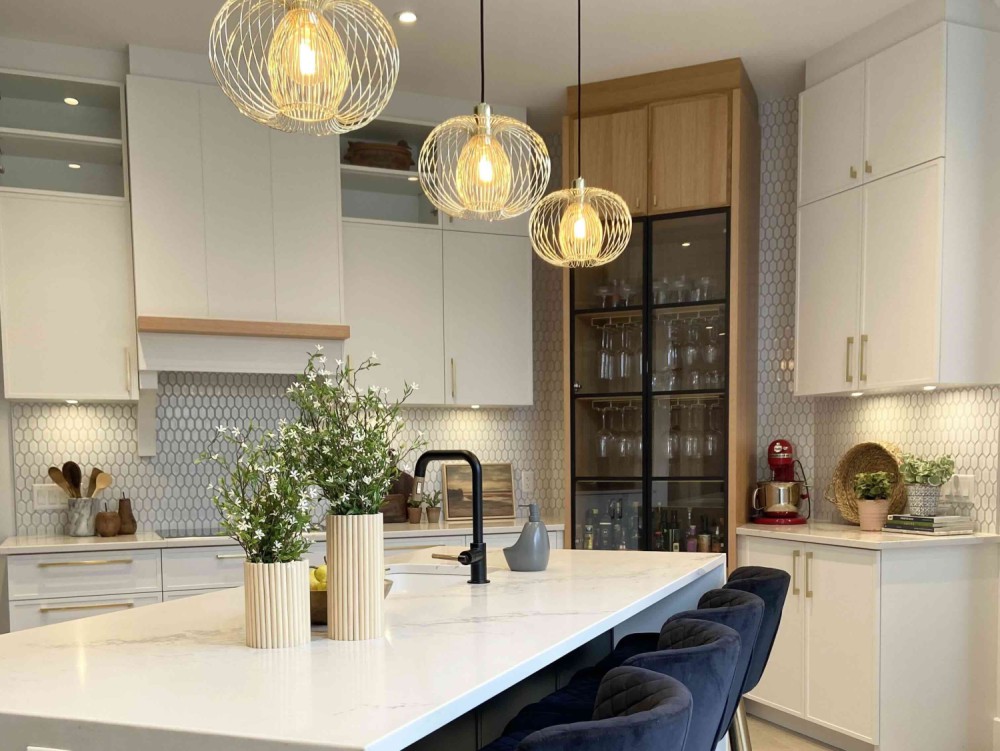Creating a timeless decor is about investing in a renovation that will last for many years, without going out of style and without it being frozen in time. Since undertaking sustainable renovations involves significant costs, here are several key points to consider before starting your project!
1. How do you define a timeless decor and sustainable renovations?
Investing in the right way requires thinking about putting money on the right things throughout your renovation project. For example, it’s better to invest in a good-quality faucet rather than in high-priced ceramic. The goal is to be aware of how you’re spending your money; smart choices allow for a design that’s not only sustainable, but also economical in the long run.
Making choices that are sustainable over time also means opting for top-quality materials such as wood in natural tones and kitchen cabinets in neutral colours. You should also avoid "trendy" colours, especially when it comes to elements that come with a heftier price tag, such as custom cabinetry. You should favour classic choices and a timeless style that will stay relevant for years to come.
Another important point before embarking on your renovation project is to be consistent with the architecture of the house. Too often, we see an interior style that’s not cohesive with the exterior of the house. There are many different styles of homes that make them unique, but there’s nothing more successful and durable than a total coherence between the interior and exterior.
2. Let’s talk budget and timeless design
You need to ask yourself this important question before starting a renovation project: Are you renovating for yourself or to sell? This is very important, because it’s what will determine the budget, but also what’s worth doing. If you want to renovate for yourself and have no intention of selling your house, the investment will probably be bigger and more personalized as well. And you’ll probably want to make improvements that are in line with your lifestyle habits. Renovating to sell your home means making the house attractive to a large pool of potential buyers. Who are the buyers in your neighbourhood? First-time buyers, retirees, or families? This is important to know in order to decide what kind of renovations you should be doing. You want to renovate for future buyers, improve your home, and create a look and feel that potential buyers will fall in love with when visiting.
When you start the process of setting a budget, you need to shop around and set realistic spending goals. Prices have gone up a lot and we don't have the same benchmarks as we did a few years ago. Sticking to your budget is doable, but very difficult to predict without plans. Don't forget that you should also include a 15 to 20% margin in your budget for unforeseen events. Because, yes, unexpected “surprises” pop up in every project, even the best managed ones.
It's also important to invest according to the neighbourhood, i.e. do some research to see how much houses are selling for in your area. Are all the houses on your street renovated? What’s the value of the houses in your neighbourhood? The idea is to invest an amount that makes sense for the area in which you live. You don't want to have the least attractive house on the street, but investing too much money in relation to the neighbourhood is also not a good idea because you risk leaving money on the table once you sell.
Surrounding yourself with professionals (ideally by word of mouth or with excellent reviews) is essential for everything to go smoothly.
Step number one is to consult a designer who will be able to produce layout, expansion, elevation, and 3D plans, as well as all the detailed plans (plumbing, electricity, floor installation, etc.). Subsequently, with these plans in hand, it will be easier to get quotes from contractors, as well as for all the necessary materials. This will give you a better idea of the scope of the project.
Did you know that renovating is far from being an expense?
In fact, the return on investment for a kitchen and/or bathroom (the most important rooms in a house) is 75 to 100% and for a garage, a finished basement, or a well-landscaped outdoor yard it’s between 55 and 75%.
These are very interesting figures, because in addition to benefitting from the renovations yourself, your home’s value will increase every year and the investment will be recouped once you sell.
3. What are some smart and sustainable choices for a timeless and elegant style?
Whether you’re looking to upgrade your kitchen, bathroom, or furniture, your best bet is to opt for a classic and transitional style that will look good for years to come. When it comes to materials, opt for quality where it counts the most, so that your renovations stand the test of time. Also choose classic installations, for example a "brick effect" kitchen backsplash and tone-on-tone grout that doesn’t contrast with your tiles. The best colours are neutrals; think greige, white, and/or pale wood.
When it comes to flooring, wood is always a good option—it’s classic and inviting and looks stylish in almost every room . . . even the kitchen. The idea is to avoid having too many different flooring styles, as you want to create a visual and lasting uniformity. Tiles are always a great option for the foyer, bathroom, laundry room, and kitchen. If you opt for vinyl or floating flooring, you should know that even in these materials, the qualities have greatly evolved over the years. The floating floors available on today’s market look like real wood—the texture, colour, and finish—especially when you opt for a high-end natural wood-toned product. Plus, the durability of this type of flooring means you won’t have to change it for a long, long time.
For kitchen or bathroom cabinets, which you want to keep for a long time, neutral and lighter tones are your best bet. Same goes for the simplicity of the design of the doors, handles, and countertops. If you like colour, it's best to use it as an accent. For example, hanging a painting that features a punch of colour, placing a colourful rug on the floor, having an accent chair in your favourite colour, or painting an antique piece of furniture.
In conclusion, remember that planning ahead, surrounding yourself with professionals, and asking the right questions are all excellent ways of turning your timeless decor project into a reality . . .

